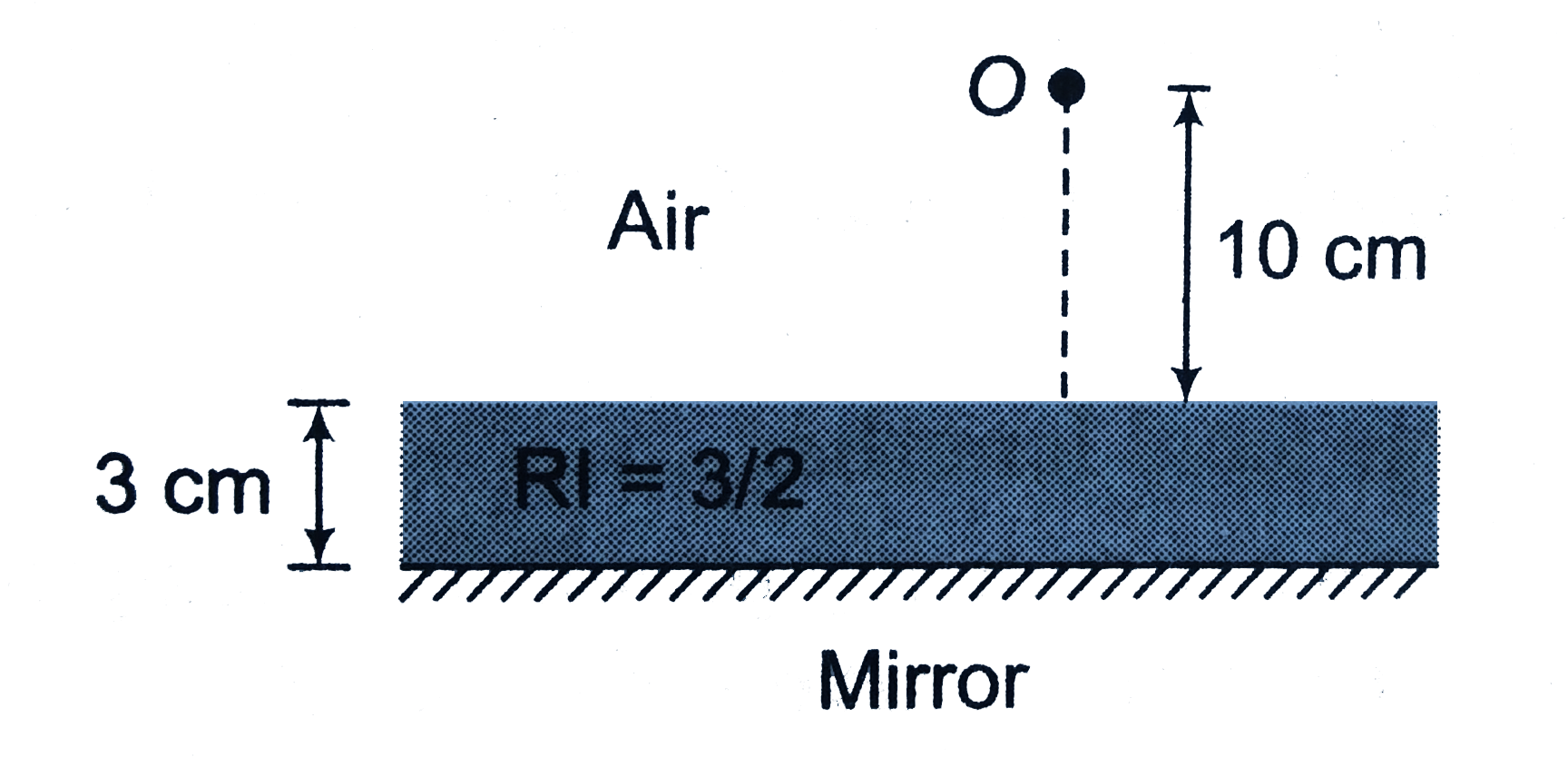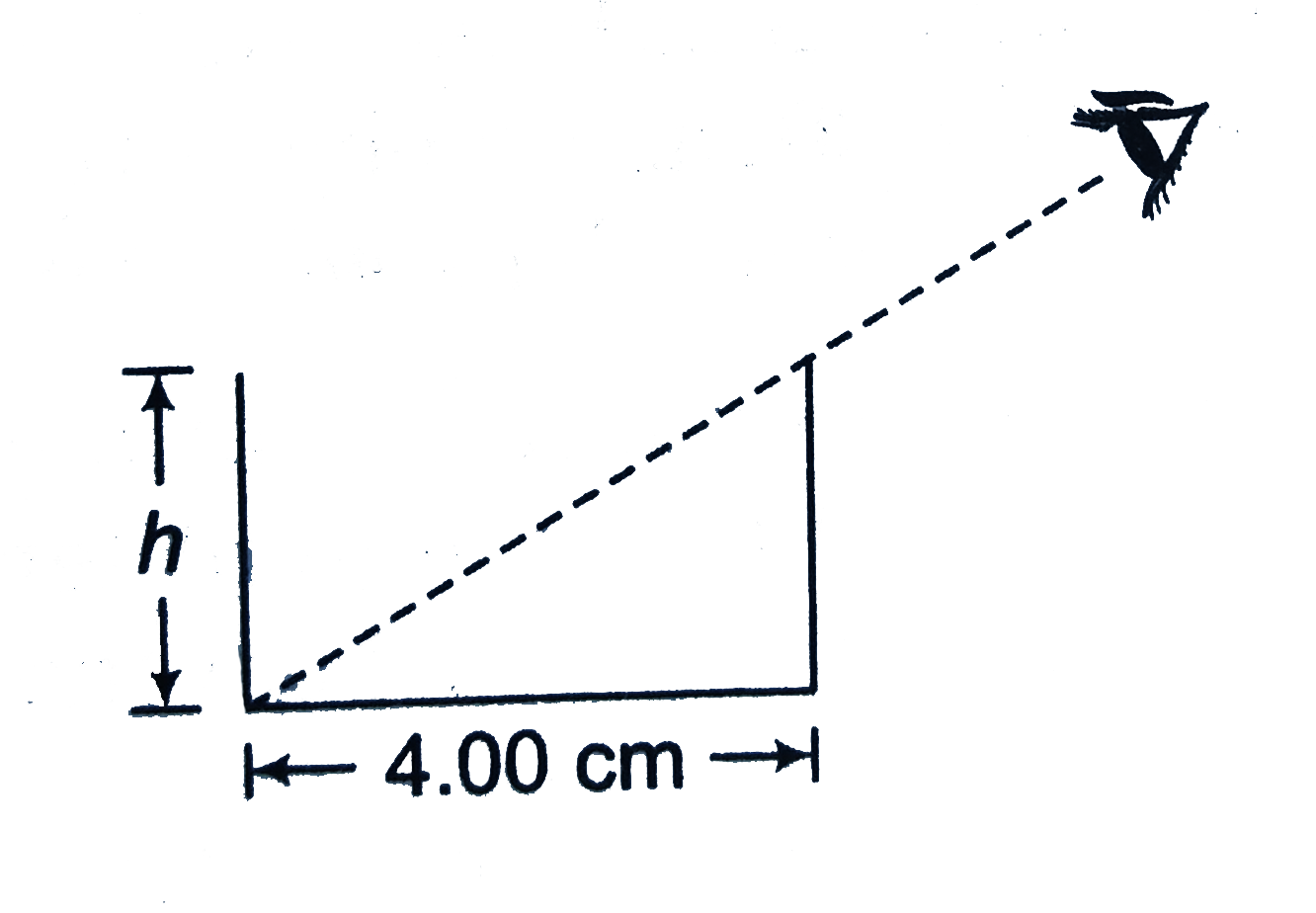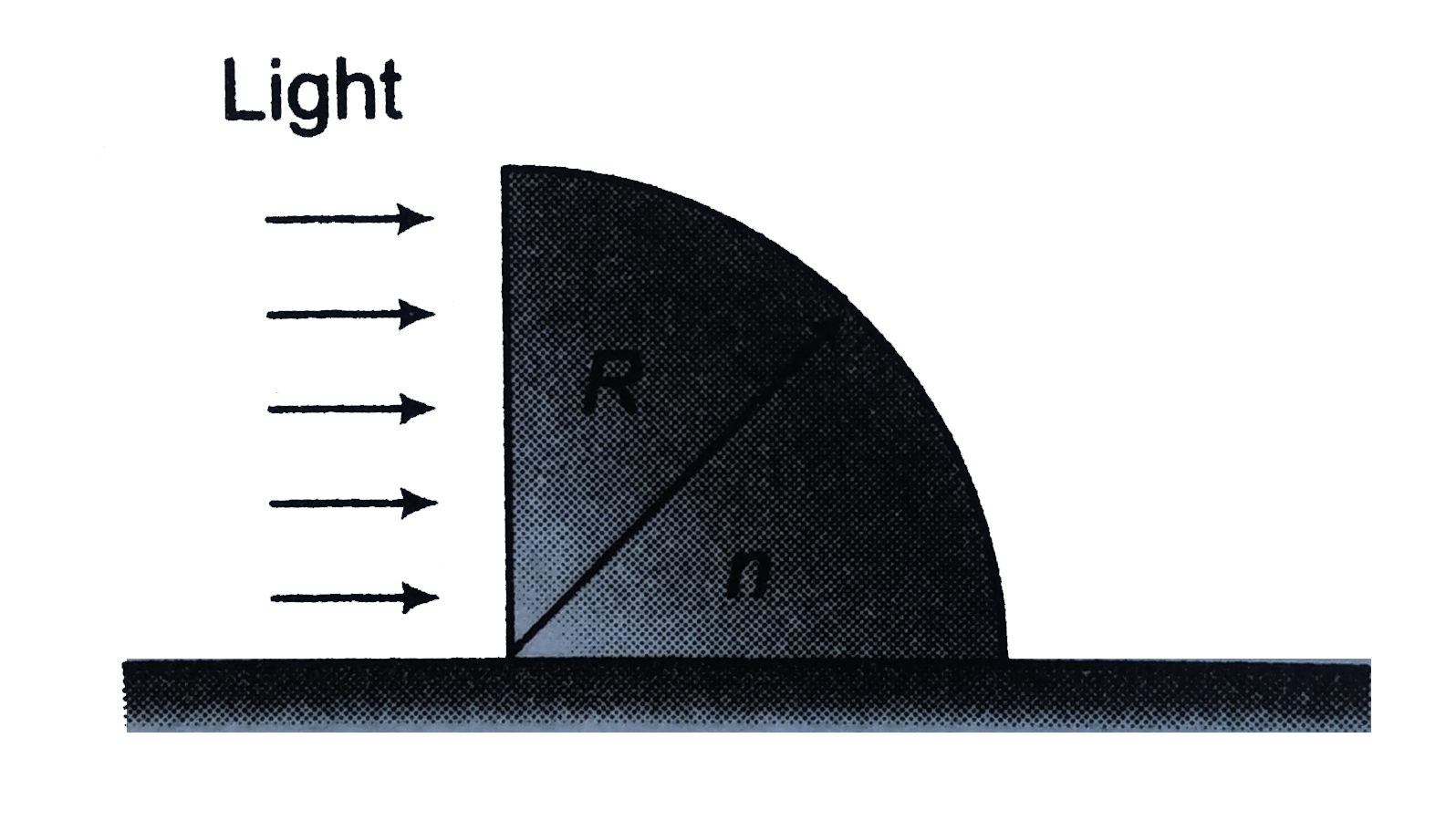Complete Solutions to Level 1 Subjective of chapter REFRACTION OF LIGHT of Class 12 book with complete answers and questions
| Class 12 | PHYSICS |
| Chapter | REFRACTION OF LIGHT |
| DC PANDEY | Level 1 Subjective |
| Number Of Questions | 29 |
| Academic Year | 2023-24 |
The laws of reflection or refraction are the same for sound as for light. The index of refraction of a medium (for sound) is defind as the ratio of the speed of sound in air `343 m//s` to the speed of sound in the medium.
What is the index of refraction (for sound) of water `(v=1498 m//s)`?
What is the critical angle `theta`, for total reflection of sound from water?01:30View SolutionLight from a sodium lamp `(lambda_0=589 nm)` passes through a tank of glycerin (refractive index `=1.47`) `20m` long in a time `t_1.` If it takes a time `t_2` to transverse the same tank when filled with carbon disulfide (index`=1.63`), determine the difference `t_2-t_1.`
01:50View SolutionA light beam of wavelength `600nm` in air passes through film `1(n_1=1.2)` of thickness `1.0 mu m`,then through film `2`(air) of thickness `1.5mu m`, and finally through film `3(n_3=1.8)` of `thickness `1.0mu m`.
(a) Which film does the light cross in the least time, and what is that least time?
(b) What are the total number of wavelength (at any instant) across all three films together?04:21View SolutionAn object is at a distance of `d=2.5 cm` from the surface of a glass sphere with a radius `R=10 cm.` Find the position of the final image produced by the sphere. The refractive index of glass is `mu_1.5.`
04:17View SolutionAn air bubble is seen inside a solid sphere of glass `(n=1.5)` of `4.0 cm` diameter at a distance of `1.0 cm` from the surface of the sphere (on seeing along the diameter). Determine the real position of the bubble inside the sphere.
02:45View SolutionFind the position of final image of an object O as shown in figure.
 03:20View Solution
03:20View SolutionOne face of a rectangular glass plate `6 cm` thick is silvered. An object held `8 cm` in front of the unsilvered face forms an image `10 cm ` behind the silvered face.Find the refractive index of glass. Consider all the three steps.
06:54View SolutionA shallow glass dish is `4.00 cm` wide at the bottom as shown in figure. When an observer's eye is positioned as shown, the observer sees the edge of the bottom of the empty dish. When this dish is `4.00 cm` wide at the bottom as shown in figure. When an observer's eye is positioned as shown, the observer sees the edge of the empty dish. When this dish is filled with water, the observer sees the centre of the bottom of the dish. Find the height of dish `mu_w=4//3.`
 02:47View Solution
02:47View SolutionA glass prism in the shape of a quarter cylinder lies on a horizontal table. A uniform, horizontal light beam falls on its vertical plane surface as shown in the figure. If the radius of the cylinder is `R=5 cm` and the refractive index of the glass is `n=1.5,` where on the table beyond the cylinder, will a path of light be found?
 03:36View Solution
03:36View SolutionA glass sphere with `10 cm` radius has a `5 cm` radius spherical hole at its centre. A narraow beam of parallel light is directed into the sphere. Where, if anywhere, will the sphere produce an image? The index of refraction of the glass is `1.50.`
05:33View SolutionA glass sphere has radius of `5.0 cm` and a refractive index of `1.6.` A paperweight is constructed by slicing through the sphere on a plate that is `2.0 cm` from the centre of the sphere and perpendicular to radius of the sphere that passes through the centre of the circle formed by the intersection of the plane and the sphere. The paperweight is placed on a table and viewed from directly above an observer who is `8.0 cm` from the table top, as shown in figure. When viewed through the paperweight, how far away does the table top appear to the observer?
02:21View SolutionA fish is rising up veritcally inside a pond with velocity `4 m//s,` and notices a bird, which is dividing downward and its velocity appear to be `16 m//s` (to fish). What is the real velocity of the diving bird, if refractive index of water is `4//3?`
04:25View SolutionA lens with a focal length of `16 cm` produces a sharp image of an object in two positions, which are `60 cm` apart. Find the distance from the object to the screen.
01:22View SolutionTwo glasses with refractive indices of `1.5 and 1.7` are used to make two indentical double convex lenses.
Find the ratio between their focal lengths.
How will each of these lenses act on a ray parallel to its optical axis if the lenses are submerged into a transparent liquid with a refractive index of `1.6?`03:34View SolutionA converging beam of rays in incident on a diverging lens. Having passed through the lens the rays intersect at a point `15 cm` from the lens. If the lens is removed, the point where the rays meet, move `5 cm` closer to the mounting that holds the lens. Find the focal length of the lens.
05:35View SolutionA parallel beam of rays is incident on a convergent lens with a focal length of `40 cm.` Where a divergent lens with a focal length of `15 cm` be placed for the beam of rays to remain parallel after passing through the two lenses.
03:26View SolutionAn optical system consists of two convergent lenses with focal length `f_1=20 cm and f_2=10 cm.` The distance between the lenses is `d=30 cm.` An object is placed at a distance of `30 cm` from the first lens. At what distance from the second lens will the images be obtained ?
03:42View SolutionDetermine the position of the image produced by an optical system consisting of a concave mirror with a focal length of `10 cm` and a convergent lens with a focal length of `20 cm.` The distance from the mirror to the lens is `30 cm` and from the lens to the object is `40 cm.` Consider only two steps. Plot the image.
04:13View SolutionA parallel beam of rays is incident on a consisting pf three thin lenses with a common optical axis. The focal length of the lenses are equal to `f_1=+10 cm and f_2=-20 cm, and f_3=+9 cm` respectively. The distance between the first and the second lens is `15 cm` and between the second and the third is `5 cm.` Find the position of the point at which the beam converges when it leaves the system of lenses.
03:22View SolutionA ray of light travelling in glass `(mu_g=3//2)` is incident on a horizontal glass-air surface at the critical angle `theta_C.` If a thin layer of water `(mu_w=4//3)` is now poured on the glass-air surface. At what angle will the ray of light emerges into water at glass-water surface?
02:39View SolutionA ray of light is incident on the left vertical face of glass cube of refractive index `n_2,` as shown in figure. The plane of incidence is the plane of the page, and the cube is surrounded by liquid (refractive index`=n_1`). What is the largest angle of incidence `theta_1` for which total internal reflection occurs at the top surfaces?
 03:58View Solution
03:58View SolutionLight is incident from glass `(mu_g=3/2)` to water `(mu_w=4/3).` Find the range of the angle of deviat on for refracted light.
03:20View SolutionThe angle of minimum deviation for a glass prism with `mu=sqrt3` equals the refracting angle of the prism. What is the angle of the prism?
02:12View SolutionA ray incident on the face of a prism is refracted and escape through an adjacent face. What is the maximum permissible angle of the prism, if it is made of glass with a refractive index of `mu=1.5`?
01:14View SolutionIn an equilateral prism of `mu=1.5,` the condition for minimum deviation is fulfilled. If face AC is polished
Find the net deviation.
If the system is placed in water what will be the net deviation for same angle of incidence? Refractive index of water `=4/3.` 10:22View Solution
10:22View SolutionIn a certain spectrum produced by a glass prism of dispersive power `0.0305,` it is found that the refractive index for the red ray is `1.645.`and that for the violet ray is `1.665`. What is the refractive index for the yellow ray?
01:51View SolutionAn achromatic lens-doublet is formed by placing in contact a convex lens of focal length `20 cm` and a concave lens of focal length `30 cm.` The dispersive power of the material of the convex lens is `0.8.` Determine the dispersive power of the material of the concave lens. Calculate the focal length of the lens-doublet.
02:49View SolutionAn achromatic convergent lens of focal length `150 cm` is made by combining flint and crown glass lenses. Calculate the focal length of both the lenses and point out which one is divergent if the ratio of the dispersive power of flint and crown glasses is `3:2.`
04:21View SolutionThe index of refraction of heavy flint glass is `1.68` at `434 nm` and `1.65` at `671nm`. Calculate the difference in the angle of deviation of blue `(434 nm)` and red `(671 nm)` light incident at `65^@` on one side of a heavy flint glass prism with apex angle `60^@`.
06:33View Solution
Level 1 Subjective questions and complete solutions for chapter REFRACTION OF LIGHT of DC PANDEY PHYSICS (HINGLISH) of Class 12
All Exercises from DC PANDEY Class 12 PHYSICS REFRACTION OF LIGHT
- Example
- Example Type 10
- Example Type 11
- Exercise 31.1
- Exercise 31.2
- Exercise 31.4
- Exercise 31.5
- Exercise 31.6
- Exercise 31.7
- Exercise 31.8
- Introductory exercise
- Level 1 Assertion And Reason
- Level 1 Objective
- Level 1 Subjective
- Level 2 Comprehension Based
- Level 2 More Than One Correct
- Level 2 Single Correct
- Level 2 Subjective
- more than one correct option
- Objective Questions
- Single Correct Option
- Solved Example
- Subjective Questions
